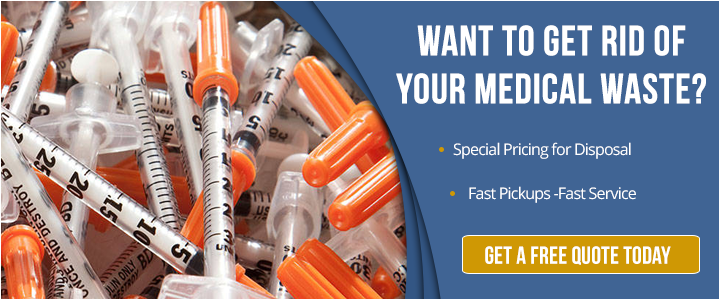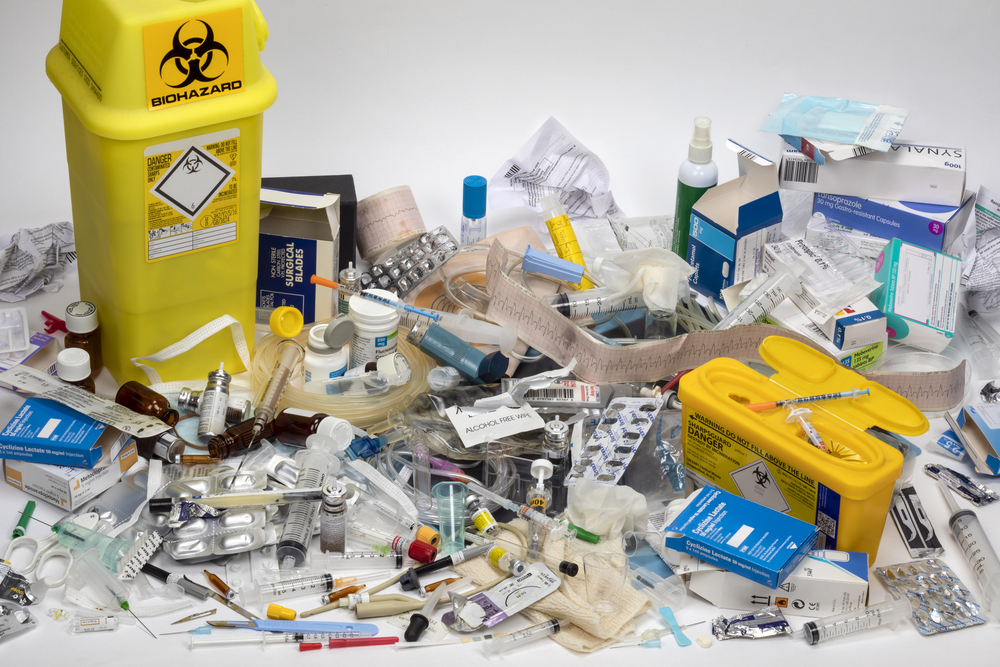
Medical waste may come from a variety of sources, but nearly all types of medical waste have one thing in common: They require a specialized level of care when it comes to disposal.
That’s because there are considerable toxicity concerns when it comes to managing and disposing of medical waste. The unintended release of chemical or biological hazards, including drug-resistant microorganisms, into the environment, is a significant concern when it comes to protecting the health of the general public and nature.
Considering just one staffed bed in the United States can produce nearly 33 pounds of medical waste every day, it’s critically important that all medical waste be properly managed.
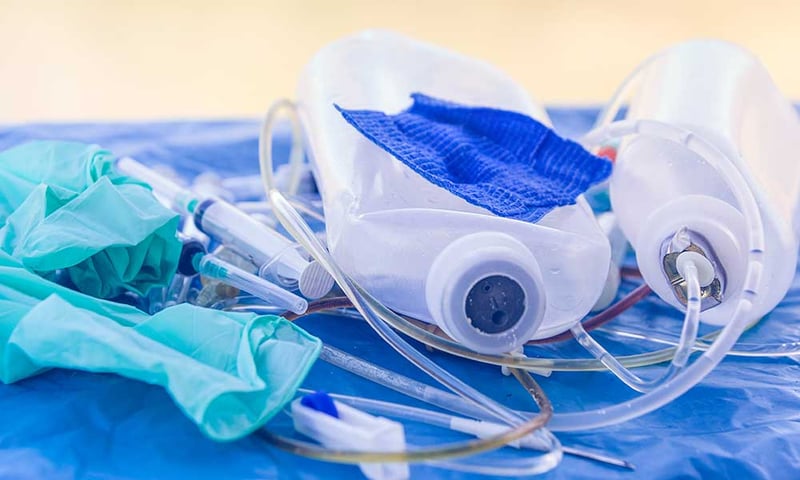
But that’s often where similarities of medical waste end. There are many different types of medical waste, from pharmaceutical to chemotherapy, dental and laboratory. Some waste is considered hazardous; other types of medical waste can be disposed of in the same trash receptacles with other waste.
Yet no matter what type of medical waste your facility generates, you are responsible for ensuring that it is properly disposed of or your organization could face costly penalties.
When planning your long-term management of the medical waste your facility generates, you should consider:
Below we’ll explore each of these areas, as well as how an experienced waste disposal company may be the best solution for all of your medical waste needs.
There are several types of medical waste. The types of waste you produce will likely determine how you handle the disposal of that waste.
Some of the most common types of chemical waste found in medical facilities include:
Improper chemical waste disposal can have devastating effects on waterways, soil, wildlife and human life, yet discarding hazardous chemicals down the drain is one of the most common hazardous waste violations found in hospitals.
Laboratory waste can be found in a variety of medical environments, from hospitals to university labs. Proper laboratory waste disposal is critical to avoiding fines, health risks and explosive consequences.
Laboratories can create a variety of waste, from needles to chemicals, biohazards, drugs, mixtures and solutions, and cleaning agents. Hazardous waste can also be in liquid, solid or compressed gas form as well.
While some chemicals may require certain disposal methods, others can be recycled. For example, chemicals like ethyl alcohol, xylene and formalin can be recycled, distilled or filtered. Laboratory waste management involves having a Hazardous Materials Business Plan in place to keep the many different types of waste found in labs organized.
Some pharmaceutical waste is considered hazardous based on its ignitability, corrosivity, reactivity and toxicity. Listed hazardous wastes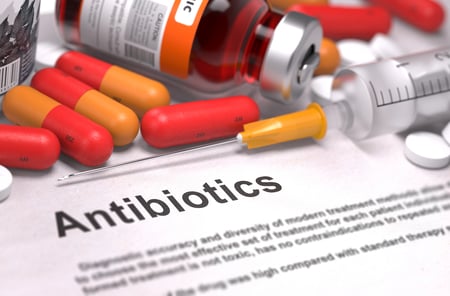 include a variety of drugs, from epinephrine to nitroglycerin and many chemotherapy agents.
include a variety of drugs, from epinephrine to nitroglycerin and many chemotherapy agents.
In California, the Department of Toxic Substances Control (DTSC) regulates pharmaceutical wastes. The state’s hazardous waste laws govern the management of waste pharmaceuticals that meet the federal definition of hazardous waste found in Title 40 Code of Federal Regulation (40CFR) 261.3.
Pharmaceutical wastes produced by households and certain small, non-household generators, known as Conditionally Exempt Small Quantity Generators (CESQGs) are not regulated as hazardous waste.
It’s important to keep in mind as well that certain pharmaceuticals generated by Small and Large Quantity Generators of RCRA waste that do not meet the federal definition of hazardous waste may still be regulated under the California Medical Waste Management Act. An experienced pharmaceutical waste disposal expert can help differentiate which types of pharmaceutical waste are regulated to ensure you meet all disposal laws.
As mentioned above, certain chemotherapy agents fall within the definition of medical waste. In fact, chemotherapy treatments generate some of the most hazardous types of medical waste.
Types of chemotherapy waste include controlled substances like morphine and hydrocodone, and trace chemotherapy waste like IV bags, tubing, vials and syringes. Bulk chemotherapy waste are drugs that do not meet the threshold for being considered “empty” by the RCRA, as well as items that are used in the event of a spill or extremely contaminated personal protective equipment (PPE).
Chemotherapy waste disposal companies can help identify chemotherapy wastes through sampling and testing, ensuring extremely toxic materials are properly disposed of and you are following all state and federal regulations.
Dental waste management involves separating dental waste streams to ensure toxic materials are not disposed of improperly.
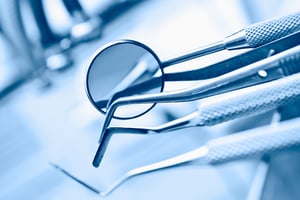 In dental care facilities, some of the most common hazardous substances include mercury, dental amalgams used for fillings and x-ray developer chemicals. Lead is also used in dental offices as foil for x-ray packets, x-ray protective aprons and boxes for storing x-ray film.
In dental care facilities, some of the most common hazardous substances include mercury, dental amalgams used for fillings and x-ray developer chemicals. Lead is also used in dental offices as foil for x-ray packets, x-ray protective aprons and boxes for storing x-ray film.
Biomedical wastes are another concern in dental offices, as blood-saturated dental gauze, swabs and compresses are common. Sharps are typically used as well and should be handled appropriately to ensure no one is inadvertently stabbed by these potentially infectious items.
While many types of medical waste are considered hazardous, the majority of medical waste (85%) is not classified as hazardous, according to the World Health Organization.
Examples of non-hazardous medical waste include plastic packaging, clean glass and plastic, paper and cardboard, and office products. Many medical products and treatments are stored in aerosol cans. In California, aerosol cans are not considered hazardous waste as long as they are completely depleted.
Keep in mind that even though some types of waste aren’t exclusive to medical environments, such as food or fluorescent lights, they are still often found in medical environments.
As a healthcare or laboratory facility, you are still required to properly dispose of this waste. Non-medical waste removal may include developing a plan to take care of items like kitchen waste, solid waste and universal hazards like pesticides, cleaning fluids and batteries.
In fact, the improper management of mercury is one of the most common hazardous waste violations found in hospitals. Mercury is typically found in fluorescent bulbs and thermostats … both found in all types of work and home environments.
There’s also electronic waste as well. Examples of e-waste found in medical facilities may include lab equipment, computers, servers, tablets and televisions.
Considering that California has some of the most strict e-waste laws on the books, it’s important that hospitals and other medical facilities properly recycle or dispose of any electronic waste that is no longer functional or needed.
Most medical waste generators are aware that they have responsibilities under the Resource Conservation and Recovery Act (RCRA). This comprehensive piece of environmental law, passed in 1976, created a system for controlling hazardous waste from the time it is generated to its final disposal.
However, many generators fail to realize that meeting these cradle to grave requirements falls on them and that they are responsible for any hazardous waste they generate even during the disposal process.
Medical waste disposal regulations are extremely important and any deviation from them can be a costly mistake. However, because there are many types of medical waste, it can be confusing to understand what your responsibilities are for each type. You can click the image below to review the Medical Waste Management Act that is in place.
Biohazard waste disposal, for example, comes with its own set of hazards in addition to environmental contamination. Infection from bacteria, viruses and parasites all pose a risk to human health if an individual comes in contact with improperly disposed of biohazard waste. The correct use of medical waste disposal containers, biohazardous bags, labels and secondary packaging is a critical component during the cradle to grave process.
You can read more about important laws in place that are specific to biohazard waste in our article, What Are California’s Biohazard Medical Waste Disposal Guidelines?
How to dispose of lab chemicals presents another challenge for many medical and laboratory facilities since chemical waste is highly regulated by state and federal laws. The Occupational Safety and Health Administration (OSHA) requires that chemical manufacturers provide Safety Data Sheets (SDSs) for every hazardous chemical. These sheets, formerly known as Material Safety Data Sheets, are standardized documents that contain health and safety data about specific chemicals.
Correctly identifying and labeling medical waste is a common thread across all types of medical waste, but it’s important to keep in mind that this is just one component of your responsibilities under medical waste laws. Remember, even though you may properly label and dispose of your waste in the correct containers, if those containers are not properly disposed of, you are responsible for the fallout should any harm occur.
Before any waste is disposed of in landfills, it must be determined whether that waste is safe. There are several treatment technologies that sterilize medical waste before it is disposed of, effectively making it less hazardous.
Treatment of medical waste helps ensure infectious waste, potentially infectious materials or toxic items do not seep into the soil or nearby water sources at landfills and create a risk to the environment and the general public.
Below are some of the treatments being used today:
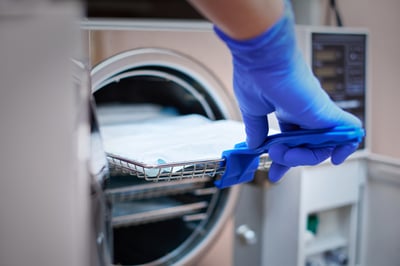 Autoclaving provides sterilization through steam. Though autoclaving is a good solution for sterilizing microbiological wastes, it is not an appropriate solution for other types of waste such as pathological and toxic chemicals.
Autoclaving provides sterilization through steam. Though autoclaving is a good solution for sterilizing microbiological wastes, it is not an appropriate solution for other types of waste such as pathological and toxic chemicals.
Biological treatments use enzymes to neutralize hazardous waste, especially infectious organisms. However, this type of treatment is not yet commonly used today.
Chemical disinfection is usually reserved for chemical and liquid waste. Chlorine is a common chemical used during this process.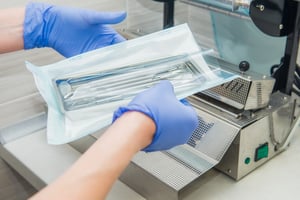 The types of microorganisms in the waste and how contaminated the product is, determine whether this is an effective choice for sterilization.
The types of microorganisms in the waste and how contaminated the product is, determine whether this is an effective choice for sterilization.
Irradiative sterilization uses the same technology as microwaves to disinfect waste. Waste is shredded and mixed with water. The waste is then heated so that all biological elements are neutralized.
Incineration is typically used as a disposal method for pathological waste and pharmaceutical waste. During this process, medical waste incinerators reach temperatures as hot as 2,000 degrees F. Trace chemotherapy waste is permitted under California law to undergo the incineration process.
Microwaving with high-powered equipment takes hazardous medical waste and turns it into non-hazardous waste using heat. Once waste becomes non-hazardous, it can be disposed of in normal landfills or through an incineration process.
Once your medical waste is properly separated, labeled and treated (if applicable), you must choose how you want to dispose of the waste in your facility.
There are different medical waste disposal methods, but not all may work for your facility. How and where to dispose of medical waste largely depends on factors like the type of waste you generate, how much waste you generate and how much time and effort you can afford to put into waste disposal.
Here are some of your options:
This may be surprising, but certain kinds of medical waste can be disposed of through recycling. Although many items one would think of as “medical” must go through special procedures for disposal, there are several items found in medical, pharmaceutical and research facilities that can be disposed of in recycling bins outside your facility or at special recycling sites.
items one would think of as “medical” must go through special procedures for disposal, there are several items found in medical, pharmaceutical and research facilities that can be disposed of in recycling bins outside your facility or at special recycling sites.
As we mentioned previously, 85% of waste that is produced by healthcare activities is non-hazardous, according to the World Health Organization.
These include items like:
There are other types of items typically found in medical facilities that can be recycled as well, though these are considered universal hazards and are subject to more stringent recycling rules. These include:
Medical waste disposal drop off sites are another option and are designed to make medical waste disposal easy. In California, there are several sites available for different types of medical waste, from sharps needles to pharmaceutical medications.
Drop-off sites can be a great choice for companies that generate small amounts of regulated medical waste that fall within the parameters of what these locations accept. However, before heading to a collection site, double-check that it can accept waste generated from a business, since some may only accept waste generated in the residential sector.
The biggest drawback of utilizing a drop-off site is the amount of waste and the type of waste you generate. Most facilities cannot accept large amounts of infectious waste, which can be an issue for many healthcare or laboratory settings. For example, one University of Maryland study estimates nearly 5,000 hospitals in the United States produce more than 7,000 tons of medical waste each day.
Many drop-off sites will only accept one type of waste, such as sharps or biomedical waste. It may be difficult as well to find a site that accepts heavily regulated medical waste. Laboratory chemical waste disposal, for instance, may require a much higher level of care during transport that your facility cannot provide.
If you regularly generate medical waste or have generated a significant amount of medical waste, an experienced waste disposal company can offer the services you need to ensure it is disposed of properly.
Hazardous waste disposal companies that are certified in handling medical waste can offer many benefits. Not only will they find a facility that will accept your particular type of waste, but they will also dispose of it ensuring you meet all cradle to grave requirements. The best disposal companies will also stay on top of changing industry conditions and regulations, saving you time and effort and allowing you to focus on the daily operations of your business or laboratory.
A waste disposal company may offer additional benefits as well, such as:
If your medical facility is located on a college or university campus, you may be familiar with lab pack services. Some disposal companies offer these services as part of their disposal process.
The purpose of a lab pack is to facilitate a chemical’s proper disposal under federal regulations. The amounts of these chemicals are generally small when compared to other generated hazardous wastes, but they are no less dangerous.
The lab pack disposal process involves first identifying, categorizing and segregating each chemical by type (solvent, acid or base), followed by re-packaging them and depositing the packaged chemicals into a drum that is no larger than 110 gallons in size.
Containers are then readied for shipment to meet all regulatory requirements, including labeling, manifesting the waste and providing any additional required shipping documents.
During the disposal process, it’s important to have precautions in place to ensure the safety of workers and the community. Here are 10 best practices to ensure the careful handling of all medical waste during disposal:
1. Employees should be able to identify medical waste. Identifying waste is an important first step before disposal since this impacts how employees package the medical waste. For example, different types of medical waste such as sharps and pharmaceutical waste go into various color-coded waste containers, which are then labeled depending on its category.
2. Staff should know all medical waste laws. Different governing bodies regulate medical waste, from the Department of Transportation to OSHA. States also many enforce more stringent hazardous waste laws than those at the federal level. It is vital for employees to know all laws and guidelines enforced by each agency that oversees your business.
3. Use the correct medical waste containers for transport. While workers can place some types of medical waste in recepticles such as cardboard boxes, other types of waste must go into special containers that are locked for transport. Employees must also properly prepare the containers for transport. This includes packaging the containers according to any legal weight restrictions and labeling them accordingly.
4. Check to make sure all waste has proper manifests and documentation. It’s important to double check that the right paperwork is accompanying each medical waste container. This paperwork identifies the type of waste being shipped, along with other pertinent information like contact numbers. You can read more about the e-Manifest system in our article, What Is A Hazardous Waste Manifest & What Do You Do With It?
5. Work with an experienced waste disposal company. Hiring a waste disposal company that has the experience and knowledge needed to safely transport your medical waste is essential. In the next section, we’ll explore what to look for in a medical waste disposal company.
Choosing the right vendor to safely dispose of your medical waste is critical. Selecting a vendor that will transport your medical waste off-site and dispose of it isn’t as simple as randomly selecting one that you find online, however.
As a hazardous waste generator, you are responsible for ensuring the safe disposal of your medical waste, which makes the medical waste disposal company you choose all the more important.
Here are five qualities that will help you choose the best medical waste disposal company for your application:
1. The Waste Disposal Company Is Licensed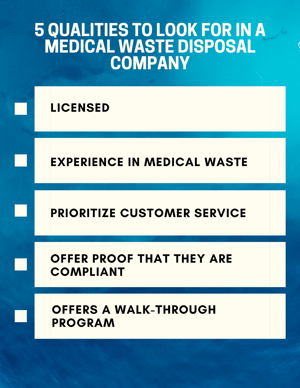
One of the most common questions asked is whether a vendor must have a medical waste disposal license. According to the California Department of Public Health, only medical waste transporters listed with the health department are allowed to transport medical waste. This regulation has been in effect since 1993.
Under this law, medical waste transporters must carry paperwork that the California Department of Public Health issues to them. To acquire this paperwork, transporters must meet a list of requirements that can be found in our article, Should Disposal Companies Have A Medical Waste Disposal License?
2. The Vendor Should Have Experience In Medical Waste
There are several types of hazardous and non-hazardous wastes that a medical provider may generate. Each type, however, may have its own set of regulations that must be followed during the transport and disposal process.
Working with a waste disposal vendor that is experienced in medical waste is a must. An experienced disposal company will not only help you identify your medical waste but will also help you determine which regulations pertain to your waste to help make the disposal process go more smoothly for you.
3. The Disposal Company Should Prioritize Customer Service
Customer service is important with any vendor you choose, but with a lot on the line, ensuring you receive the highest level of service is important. The type of customer service you receive from the moment you contact a medical waste disposal company can be a good indicator of what type of customer service you receive throughout your agreement.
Other indicators of a company with quality customer service? The best companies will offer prompt pickups, address any concerns that you have, help you package your waste properly, identify wastes through sampling and testing, and prepare labels, manifests and other paperwork as required by the government.
4. A Vendor Will Offer Proof That It Is Compliant
A medical waste disposal vendor should be upfront and able to provide you with the information you need to make the best decision for your medical or lab facility. The best vendors will provide you with:
Our article, Choosing The Right Vendor For Medical Waste Disposal Los Angeles, offers additional tips on where to look when checking a disposal company’s qualifications.
A key characteristic of an experienced disposal company is if it offers a walk-through program. This type of program offers your business the opportunity for an expert in medical waste management to evaluate your company and offer any insights into needed areas of focus, such as:
Choosing the right vendor to safely dispose of your medical waste is critical to meet your present waste management needs and to secure a long-term waste management solution for your facility.
While there are many vendors that will gladly transport your medical waste off-site, choosing one that will dispose of your waste safely and according to regulatory guidelines involves a much more thorough process than randomly selecting one online.
The best disposal companies will answer any questions you have and provide proof of their excellent track record with facilities similar to yours so that you can be assured your company’s medical waste is in safe hands. 